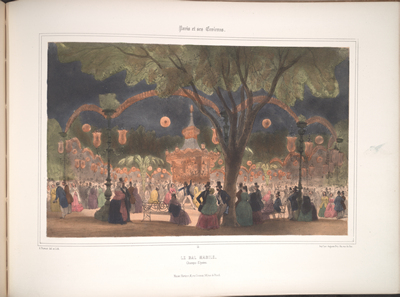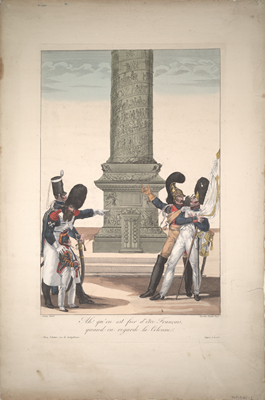 [click image to zoom]
[click image to zoom]
|
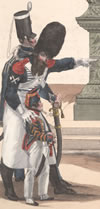
Ah! Qu'on est fier d'être français quand
on regarde la colonne.
Hand-colored engraving by Caroline Naudet-Fecit. [Paris,
chez l'auteur, 1816]. Hand-colored engraving. 55 x 36.5 cm.
Anne S.K. Brown Military Collection
|
| |
|
|

" Boulevard des Italiens "
Trollope, Francis Milton, 1780-1803
Paris and the Parisians in 1835. London : R. Bentley,
1836. Vol. 2. Drawing and etching by A. Hervieu, dated 1835.
John Hay Library Starred Books Collection
Located in the second and ninth arrondissements, the Boulevard
des Italiens was originally established in 1685, but it wasn't until
1783 that the boulevard was given its present name, inspired by the
neighboring Théâtre des Italiens. As was the case for most
of the major Parisian roadways, the boulevard des Italiens did not have
any sidewalks until 1830, thereby impacting the development of outdoor
social activities. The enormous growth in Parisian cafés, for
example, is what brought the boulevard des Italiens its fame: home to
the city's most popular gathering places, the boulevard provided a place
for the upper classes to mingle and stroll.
|
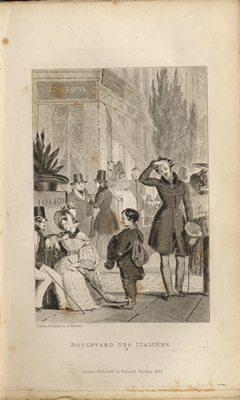
[click image to zoom]
|
| |
|
|
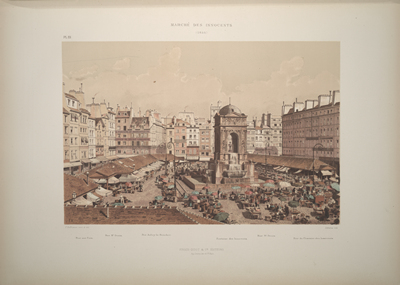
[click image to zoom] |
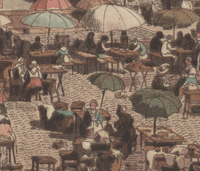
" Marché des Innocents, 1855 "
Hoffbauer, 1839-1922
Paris à travers les âges : aspects successifs des monuments
et quartiers historiques de Paris depuis le XIIIe siècle jusqu'à
nos jours / fidèlement restitués d'après les documents
authentiques par M. F. Hoffbauer ; texte par MM. Édouard Fournier,
Paul Lacroix, A. de Montaiglon, A. Bonnardot, Jules Cousin, Franklin,
Valentin Dufour, etc.
Paris : Firmin-Didot, 1875-1882. Vol. 2, chapitre IV, pl. III. Colored
lithograph by Sabatier ; drawing by F. Hoffbauer.
John Hay Library Starred Books Collection
The Marché des Innocents was opened in 1788 in the place of
what used to be Paris's largest cemetery, the Cimetière des Innocents.
This market, located in the first arrondissement, served as a central
location for Parisians to purchase various herbs and vegetables. The
sellers' stands were protected by brightly colored parasols, each four
to five meters in diameter. In addition to the hundreds of vendors,
the market also housed the occasional café and was at one time
a place where homeless Parisians could go in the winter for a bowl of
hot soup.
The Fontaine des Innocents, originally erected in 1549, was transferred
to the center of the market in the early 19th century. Although highly
decorative, the fountain's four basins served as a sufficient source
of water for the entire market. The Marché des Innocents officially
closed in 1858 to make way for the popular les Halles marketplace. In
1865, the fontaine des Innocents was once again relocated to what is
currently known as the Place des Innocents.
|
| |
|
|
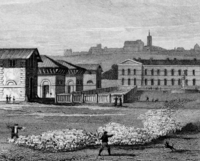
" Abattoir at Montmartre "
Pugin, Augustus, 1762-1832
Paris and its environs, displayed in a series of two hundred
picturesque views, from original drawings. London: Jennings and Chaplin,
62, Cheapside; [Finsbury], J. Haddon, Printer, Castle Street, Finsbury,
1831. Drawing by A. Pugin; engraving by H. Wallace. Top of p. 2.
John Hay Library Starred Books Collection
In 1810, in an attempt to appease the complaints of many
Parisians, Napoléon I ordered that five slaughtering houses,
or "abattoirs," be built just outside of Paris: three on the
right bank, and two on the left. These areas were to be the only designated
locations where butchers were allowed to slaughter cattle. The abattoir
of Montmartre, shown here, was located between the rues Rochechouart,
de la Tour d'Auvergne, and des Martyrs, and measured 1074 feet by 384
feet.
|
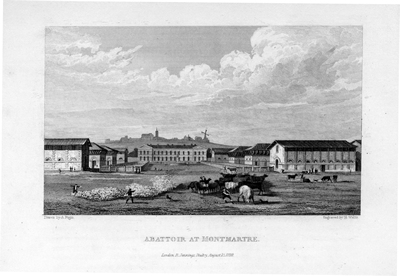
[click image to zoom]
|
| |
|
|
|

"Quartier de Grenelle"
Les quartiers de Paris.
[Paris : Imp. D'Aubert & cie, undated]. Colored plate by Bouchol.
No. 37.
Anne S. K. Brown Military Collection
It was not until the end of the 19th century that most Parisians had
sufficient drinking water flowing directly into their homes. Because
water from nearby rivers and streams was undrinkable, citizens relied
on the many wells that were built throughout the capital city. In the
1830s, a number of new artesian wells were created in Paris, particularly
in the neighborhood of Grenelle. Construction on one of the most famous
Grenelle wells began in 1833, but encountered technical difficulties
and was not completed until 1841. Scientists and city planners alike
paid particular attention to the temperature of the water at the various
wells, which was generally warm. Wells continued to serve as adequate
sources for drinking water throughout the 1800s, and by 1875 there were
an estimated 30,000 wells in Paris.
|
| |
|
FIGURES: |
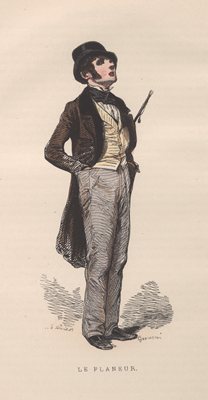 [click image to zoom]
[click image to zoom] |
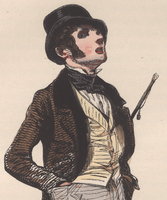
" Le flâneur "
Les Français peints par eux-mêmes : encyclopédie
morale du dix-neuvième siècle
Paris, L. Curmer, 1840-42. Vol. 3, p. 65. Colored wood engraving by
Louis, drawing by Nicolas Toussaint Charlet.
John Hay Library Starred Books Collection
Known as the "personnification toute française," the
flâneur was a figure that reigned in Paris of the 19th century.
A keen examiner of anything that passed him by, the flâneur was
also the embodiment of a Parisian philosophy, one that relied on deep
reflection and analysis as well as observational skills
|
| |
|
|
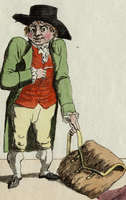
Désagrément d'être joli garçon
A Paris chez bance, rue St. Denis, près celle aux
Ours, no. 175. [1803 ?] Hand-colored engraving. 24.5 x 30.5 cm. (L'élégance
parisienne, no. 5)
Anne S. K. Brown Military Collection
The concept of the "joli garcon" (literally
"pretty boy" in English) was one that often appeared in French
social satires and literature of the 19th century. Ridiculed for both
his youthful charm and ingenuous naïveté, the distinguished
clothing of the "joli garcon" also provided caricaturists
with an opportunity to criticize the bourgeoisie.
|
|
| |
|
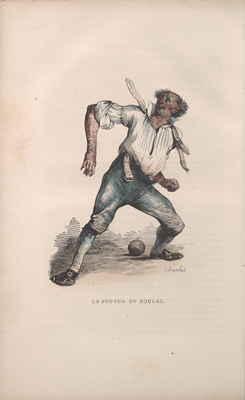
[click image to zoom] |
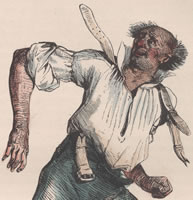
" Le joueur de boules "
Les Français peints par eux-mêmes : encyclopédie
morale du dix-neuvième siècle
Paris, L. Curmer, 1840-42. Vol. 2, p. 289. Colored wood engraving by
Louis, drawing by Nicolas Toussaint Charlet.
John Hay Library Starred Books Collection
Although originating in Italy, Bocce ball was a popular leisure activity
in 19th century France among older generations. Parks near the Champs-Elysées
attracted players and spectators alike to gather together in light-hearted
competition. The game became so popular that even the blind players
participated inside the Hôtel des Invalides.
|
| |
|
|
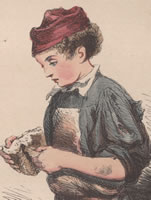
" L'enfant de fabrique "
Les Français peints par eux-mêmes : encyclopédie
morale du dix-neuvième siècle
Paris, L. Curmer, 1840-42. Vol. 1, p. 257. Colored wood
engraving by Hébert, drawing by Hippolyte Louis Emile Pauquet.
John Hay Library Starred Books Collection
In the first half of the 19th century, many Parisian factories
hired entire families in an attempt to attract more workers to the industry,
despite the horrific working conditions. Children, sometimes as young
as five years of age, were therefore exposed to the dangers of factory
work. It was not uncommon for children, both boys and girls, to be on
their feet for seventeen hours a day, and they often suffered grave
injuries that sometimes proved to be fatal. Labor laws were eventually
passed protecting women and children from the harsh working conditions
of Parisian factories.
|
 [click image to zoom]
[click image to zoom]
|
| |
|
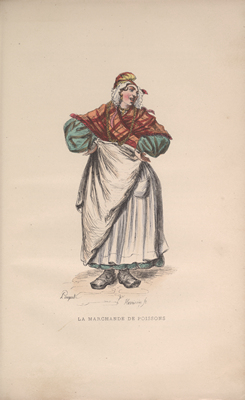 [click image to zoom]
[click image to zoom] |
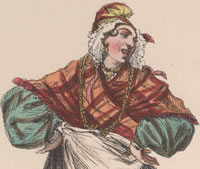 " La marchande de poissons"
" La marchande de poissons"
Les Français peints par eux-mêmes : encyclopédie morale
du dix-neuvième siècle
Paris, L. Curmer, 1840-42. Vol. 5, p. [302]. Colored wood engraving
by Harrison, drawing by Hippolyte Louis Emile Pauquet.
John Hay Library Starred Books Collection
For centuries working class women have served as vendors at various
market places throughout the capital city. Stereotyped as being an uncompromising
but productive businesswoman, the "marchande de poissons"
was a figure to be found in Parisian markets for many centuries.
|
| |
|
|

" La Colonelle "
Bertall, Albert d'Arnoux, 1820-1882
Les communeux 1871 : types, caractères, costumes.
Paris : E. Plon et Cie, printers and editors, 1880. No.
28. Hand-colored plate
Anne S.K. Brown Military Collection
The Commune was comprised of a diverse group of Parisians,
from varying social, political and economic backgrounds. The Commune's
socialist approach depended on representation of the city as a whole,
including women. Women played an active role in participating in various
committees and serving as soldiers in battles against the Versailles
government. One club, known as the "Union des femmes pour la défense
de Paris et les soins aux blessés," founded by Marx's friend
Elizabeth Dmitrieff, was an especially active association of women who
helped to aid wounded communards.
|
 [click image to zoom]
[click image to zoom] |
| |
|
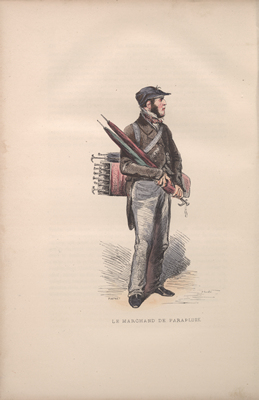 [click image to zoom]
[click image to zoom] |
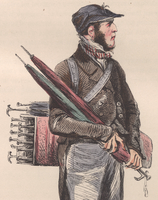
"Le marchand de parapluie"
Les Français peints par eux-mêmes : encyclopédie
morale du dix-neuvième siècle
Paris, L. Curmer, 1840-42. Vol. 4, p. 275. Colored wood engraving by
Soyer ; drawing by Hippolyte Louis Emile Pauquet.
|
| |
|
|
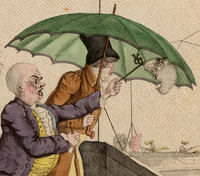
Désagrémens, des parapluies. Vue prise
sur le quai de Voltaire entre la rue de Beaune et la rue du Bacq.
A Paris : Chez Martinet, Rue du Coq, no. 124, [1806].
Artist unknown. Hand-colored engraving. 26 x 34.5 cm. (Caricatures parisiennes)
Anne S. K. Brown Military Collection
Although the umbrella was a symbol of the privilege of
the bourgeois in the latter part of the 19th century, it was considered
to be a fashion accessory in the early 1800s, despite its awkward nature.
Because few Parisians successfully mastered handling the device, caricaturists
quickly exploited the irony of such Parisians who simply wished to appear
fashionable in public.
|
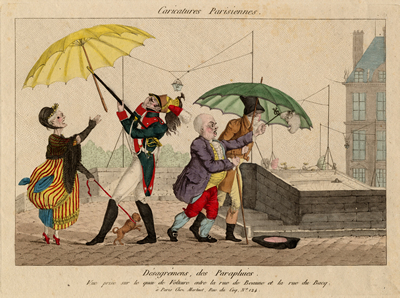 [click image to zoom]
[click image to zoom] |
ENTERTAINMENT: |
|
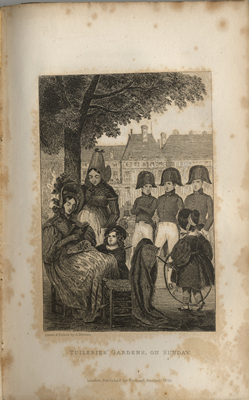
[click image to zoom]
|
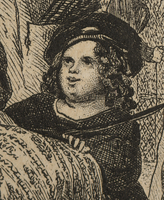
" Tuileries' gardens, on Sunday "
Trollope, Francis Milton, 1780-1803
Paris and the Parisians in 1835. London : R. Bentley, 1836. Vol. 1.
Drawing and etching by A. Hervieu, dated 1835.
John Hay Library Starred Books Collection
The Tuileries Gardens were built in 1644 by the same designer responsible
for the garden at Versailles. Although they underwent considerable architectural
changes in the centuries to follow, the Tuileries Gardens became one
of Paris's most popular recreational gathering places. By the 19th century,
the gardens offered Parisians and tourists alike a peaceful setting
featuring small bodies of water, public walkways, various terraces and
pavilions, as well as numerous statues, all of which made the gardens
the ideal setting for leisure activities. The Tuileries Gardens continue
to attract visitors today, and are located adjacent to the Louvre in
the first arrondissement.
|
| |
|
|
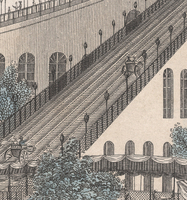
Garneray, Louis, 1783-1857.
Promenades aériennes-Jardin Baujon. Honoré de la Présence
de La Majesté, le 2 août 1817.
A Paris au Jardin Baujon, et chez Ch. Bance, Rue J.J. Rousseau, [c.
1817]. Hand-colored engraving by Jean-Nicolas Lerouge; drawing by Louis
Garneray. 34.5 x 53 cm.
Anne S. K. Brown Military Collection
Opened in Paris in 1817, the "Promenades Aériennes"
came to be recognized as the first modern roller coaster featuring two
separate tracks that lead in opposite directions and to which the coaster
cars were locked into place. The heart-shaped design and double tracks
allowed for two separate cars to descend in opposite directions, sometimes
up to 40 miles per hour, to rejoin each other at the bottom of the hill,
and then to be pushed by attendants up parallel lifts to the top of
the ride. In 1826, the "Promenades Aériennes" became
the first roller coaster to use a cable system to pulls cars to the
top, and is today known as the world's first racing coaster. The enormous
popularity of the coaster can be credited to the novelty of amusement
rides, as well as to the psychological thrill Parisians experienced
while on the ride.
|
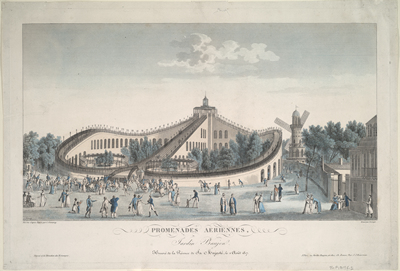 [click image to zoom]
[click image to zoom] |
| |
|
|
|
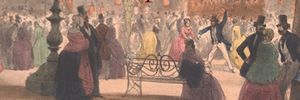
" Le Bal Mabile, Champs-Elysées "
Paris et ses environs, 1858. Grand album représentant les vues
et les monuments les plus curieux de Paris et les sites les plus remarquables
des environs.
No. 15. Paris : Maison Martinet, Impr. Auguste Bry, 14 rue du Bac,
1858. Lithograph by A. Provost.
Anne S. K. Brown Military Collection
Located at 51 boulevard des Champs-Elysées, the Bal Mabile which
opened in 1840, was one of the most trendy dance establishments in 19th
century Paris. The brothers Mabile inherited the Champs-Elysées
property from their father, previously a dance instructor, and transformed
the small country ball into a luminous garden spectacle. Because of
the recent developments of gas lighting, the Bal Mabile was open both
in the afternoon and the evening, and was decorated with illuminated
glass balls and colored garlands suspended from trees. It opened in
1840 and quickly became a popular gathering place for rich Parisians
to dance the polka and mingle in a fairy-tale setting.
|
| |
|
|
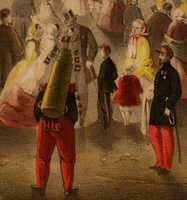
"The Italian Campaign"
Quadrille by Chas. D'Albert.
London, Chappell & co. 49 & 50 New Bond St., M. & N. Banhart,
printer, [c.1865].
Lithograph by Brandard, illustration of sheet music cover with caption
"Peage illuminations in Paris."
Anne S. K. Brown Military Collection
|
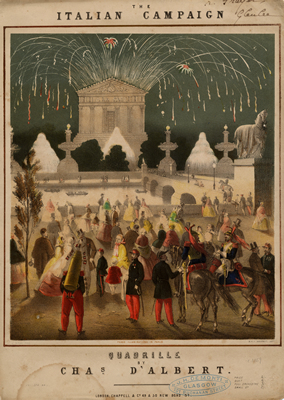 [click image to zoom]
[click image to zoom] |
| |
|
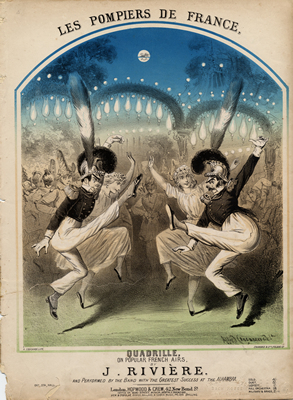 [click image to zoom]
[click image to zoom] |
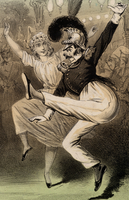
"Les pompiers de France"
Quadrille on popular French airs by J. Rivière and performed
by the band with the greatest success at the Alhambra.
London, Hopwood & Crew, 42 New Bond St., Stannard & co., printer,
[c.1859].
Lithograph by Alfred Concanen, illustration of sheet music cover.
Anne S. K. Brown Military Collection
The Quadrille, introduced in France around 1760, continued to be a
popular dance in 19th century Paris. Originally performed in sets of
two couples, the quadrille evolved into different forms and variations,
many of which were similar to the waltz and the polka.
|
| |
This page was last updated on Monday, 02-Mar-2015 12:22:37 EST.
© 2004, Brown University Library. All rights reserved
You are the [an error occurred while processing this directive]
visitor to this page since September 28, 2004.

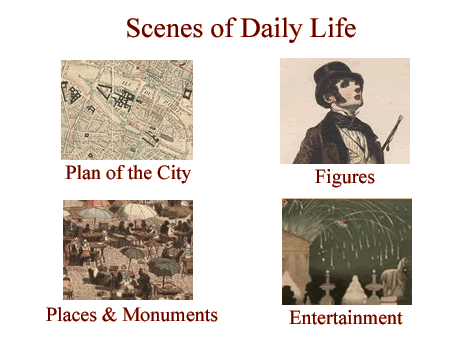
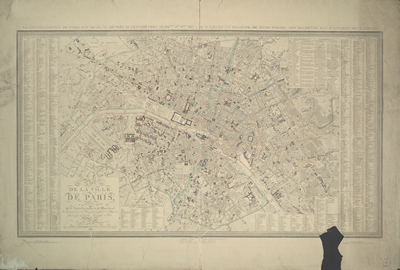








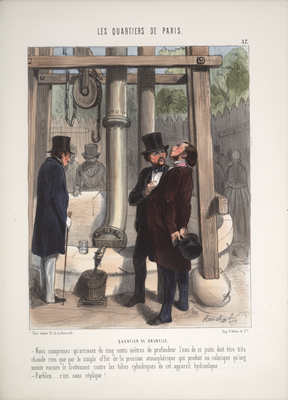




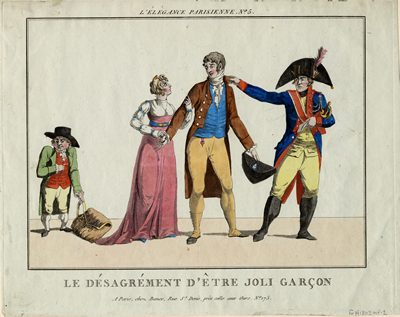





 " La marchande de poissons"
" La marchande de poissons"









